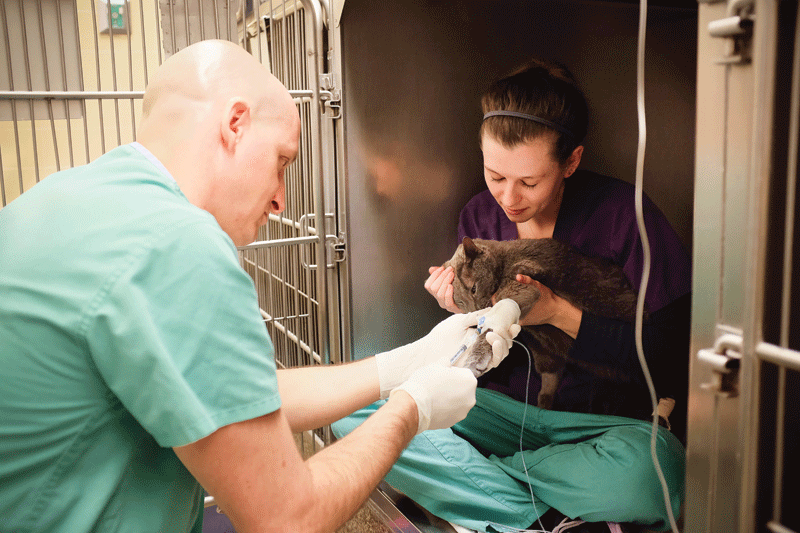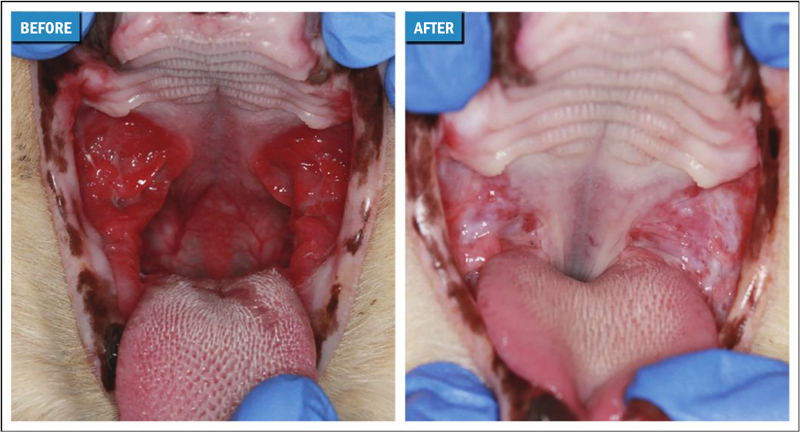
Photos courtesy Boaz Arzi
Stomatitis is one of the most difficult conditions to treat among dogs and cats, often resulting in the removal of most of—if not all—the patient’s teeth. In September 2022, the Dentistry and Oral Surgery Service at the University of California, Davis (UC Davis) Veterinary Hospital debuted its stomatitis clinic, with a focus on diagnostic and therapeutic options.
“Stomatitis cases can present significant diagnostic and therapeutic challenges,” says Maria Soltero-Rivera, DVM, DAVDC, assistant professor of dentistry and oral surgery in the Department of Surgical and Radiological Services at UC Davis.
“We hope this dedicated clinic time will help support our patients, their caretakers, and the referral community in the management of these cases. This, along with the interdisciplinary collaborations that occur at the veterinary hospital and our ability to offer viable, novel treatment alternatives to unresponsive cases will increase the quality of care offered to these patients,” says Dr. Soltero-Rivera.
Stomatitis is a general term to describe an inflamed and uncomfortable oral mucosa. Feline chronic gingivostomatitis (FCGS) is a moderate to severe form of stomatitis in cats that occurs in up to 12 percent of the species.1 Prevalence in dogs is less well understood. In both species, the disorder is associated with significant morbidity.
“Stomatitis can be caused by infectious, immune-mediated or autoimmune, medication-induced, cancerous, radiation-induced or idiopathic conditions,” says Soltero-Rivera. “We currently see a variable number of cases per month in dogs and cats. With the inauguration of the Stomatitis Clinic, we will be able to see at least five to 10 cases of stomatitis during the clinic days.”
Painful symptoms
According to Soltero-Rivera, the most common signs of stomatitis are oral pain and discomfort, which may manifest as difficulty eating or drinking, vocalization when eating, profuse salivation, decreased grooming, lethargy, and hiding behavior.
“We may also see bloody saliva and stained fur on the front limbs and neck, as well as weight loss,” Soltero-Rivera says. “The condition is typically diagnosed by evaluating the presenting clinical signs, performing an awake and anesthetized evaluation of the pet’s mouth, and obtaining samples of affected tissues for histopathological evaluation.”
Lilli, a tortoise shell tabby owned by Cynthia Luke and Michael Lewis of Davis, Calif., was a textbook example of stomatitis in cats. The couple went on vacation when Lilli was three years old, and came home a couple of weeks later to find their pet in distress. “When we returned, Lilli had lost about five pounds and her kibble was all over the floor,” Luke says. “We knew something was wrong, so we took her to our local vet, who never used the word stomatitis. She looked in Lilli’s mouth, told us there was nothing she could do, and suggested we take her to the UC Davis School of Veterinary Medicine.”
Due to the extreme pain that may result from stomatitis, the condition can have an adverse effect on an animal’s quality of life, as well as its caretakers. The pet may run away from the food bowl, avoid interacting with other pets and their caretakers, are unable to pick up toys with their mouth, and can progressively lose weight. Lilli presented with all these symptoms, Luke says.
“These pets need constant veterinary attention and sometimes lifelong medications that can have unwanted side effects,” says Soltero-Rivera. “Approximately one-third of cats affected by chronic gingivostomatitis will not respond to any treatment and owners and veterinarians may be faced with the difficult decision of euthanasia due to exceptionally poor quality of life.”
Treatment can be tricky
The treatment of stomatitis depends primarily on identifying the cause of the condition and what veterinarians have historically learned works. Pain and infection are controlled with appropriate medications as well as extraction of infected teeth, and in certain situations, immunosuppressive medications may be considered.
“In cats affected with chronic gingivostomatitis, for example, the current gold-standard treatment is the extraction of most or all of the teeth,” Soltero-Rivera says. “Even then, one-third of affected cats will show minimal to no improvement and alternative treatment options, such as stem cell therapy, immunomodulation, and pain management become necessary. In dogs affected by stomatitis, treatment also involves extraction of teeth with substantial periodontal disease, along with medical management.”
When Luke and Lewis took Lilli to UC Davis, the attending doctor told them her prognosis was poor. “Really, all we could do was give her pain medication, and antibiotics when the lesions became really infected,” Luke says. “The goal was to keep her comfortable and able to eat.”
As a result, Lilli’s quality of life was poor for several years. It was decided to have all her teeth removed in the hope the infections would ease, but the treatment proved ineffective, and Lilli became more fearful of her family. Toward the end of 2011, Luke and Lewis began discussing having Lilli euthanized.
Indeed, in the absence of a definitive known cause and the potential for multifactorial causes, the treatment of dogs and cats with stomatitis can be extremely challenging. Luckily, there has been some promising research regarding diagnostics and treatments, Soltero-Rivera says.
In the area of diagnostics, next-generation sequencing has proved a novel diagnostic method that can be used to identify active genes and associated pathways within clinical specimens obtained from sick and healthy patients. Veterinarians can evaluate patients for the presence of an array of microbes including viruses, bacteria, fungal, or parasitic organisms, and even neoplastic cells while at the same time determining how the patient is responding to the disease.
“This methodology will result in major advancements in oro-dental diagnostics, which have been traditionally limited to more subjective testing, namely dental charting and X-rays, along with histopathology at times,” Soltero-Rivera says.

Stem cells show promise
When it comes to treatment, UC Davis’s Dentistry and Oral Surgery Service has a history of pioneering treatment for feline chronic gingivostomatitis over the past decade, establishing a novel clinical trial utilizing stem cell therapy. As success of the trial grew, with 72 percent of cats treated exhibiting positive results,2 it evolved into several national trials at multiple clinics and universities around the nation. The final product for an accepted protocol of feline chronic gingivostomatitis is currently under clinical trials to enable FDA approval, says Soltero-Rivera.
Lilli was a beneficiary of UC Davis’s stem cell research. Just as Luke and Lewis were discussing having Lilli euthanized, they were informed she qualified for a new stem-cell study. The first surgery used Lilli’s own stem cells, which resulted in a small improvement. A second surgery using stem cells from a donor worked almost immediately.
“It was noticeable she was eating a lot and seemed to be happier, so I started cutting back on her medications,” Luke says. “She started playing with her sister, eating a lot, and frolicking in the backyard. Very shortly she was drug-free. We got to watch Lilli be a happy, normal cat for eight years after the surgery. It was a real gift.”
Stomatitis is difficult to treat and can be equally difficult to prevent. “To date, there are no known preventive strategies for stomatitis in dogs and cats,” Soltero-Rivera says. “Timely evaluations of the oral cavity of pets by veterinarians, as well as a strict oral care regimen at home, may help us pick up the earliest signs associated with this condition.”
As research into stomatitis continues at UC Davis and other institutions, the information gleaned will be made available to all practitioners. “The creation of a first-of-its-kind focused clinic for cats and dogs is the next step in the natural progression of our groundbreaking work in the disease,” says Soltero-Rivera. “Stomatitis cases are considered a high priority, as they have drastic negative impacts on the patient’s quality of life. As such, this dedicated time offered by the Stomatitis Clinic will provide a means to serve more animals in a timely manner. Beyond immediately helping patients in need, the clinic will be a platform for interdisciplinary and transdisciplinary research to advance knowledge on this devastating condition.”
Lilli passed away in 2020, and her family was grateful for the extra time they had with her. “Lilli enriched the lives of our family and taught us so much about love and caring for an ill loved one,” Luke says. “This experience sent my son, who was close to Lilli, down a different path as well. He went to medical school and is now in his residency.”
Don Vaughan is an award-winning writer who frequently writes about veterinary-related topics.
References
- Lee DB, Verstraete FJM, Arzi B. An Update on Feline Chronic Gingivostomatitis. Vet Clin North Am Small Anim Pract. 2020 Sep;50(5):973-982. doi: 10.1016/j.cvsm.2020.04.002. Epub 2020 Apr 18. PMID: 32360016; PMCID: PMC7194110. https://www.ncbi.nlm.nih.gov/pmc/articles/PMC7194110/
- Arzi B, Peralta S, Fiani N, Vapniarsky N, Taechangam N, Delatorre U, Clark KC, Walker NJ, Loscar MR, Lommer MJ, Fulton A, Battig J, Borjesson DL. A multicenter experience using adipose-derived mesenchymal stem cell therapy for cats with chronic, non-responsive gingivostomatitis. Stem Cell Res Ther. 2020 Mar 13;11(1):115. doi: 10.1186/s13287-020-01623-9. PMID: 32169089; PMCID: PMC7071622. https://stemcellres.biomedcentral.com/articles/10.1186/s13287-020-01623-9
- https://www.vetmed.ucdavis.edu/news/uc-davis-veterinary-hospital-opens-stomatitis-clinic (Accessed September 2022).
- https://www.ncbi.nlm.nih.gov/pmc/articles/PMC4947586/pdf/fvets-03-00054.pdf Therapeutic Management of Chronic Feline Gingivostomatitis: A Systematic Review of the Literature by Jenna N. Winer, Boaz Arzi, et al. Frontiers in Veterinary Medicine

